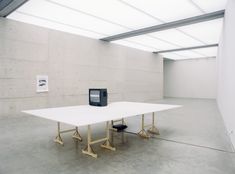Margreiter, Dorit, Mathias Poledna + Florian Pumhösl mit/with Ines Doujak + Hans Küng mit/with Heimo Zobernig
At the beginning of the nineties a loosely-knit group of young graduates from the University of Applied Arts in Vienna got together after participating in a number of joint projects that had led to the development of a new and significant art movement. Having recourse to, and developing from, critical and analytical approaches of the art of the sixties and seventies they drafted strategies which threw the basic conditions of the system under which art operates and the defining power of context into stark relief.
In 1991, in their first joint work entitled Material, Texte, Interviews Ines Doujak, Hans Küng, Dorit Margreiter, Mathias Poledna and Florian Pumhösl paradigmatically formulated a critical attitude towards the mechanisms obtaining in the art business, particularly in Vienna. The trigger point was reached with the ”Junge Szene Wien,” a biannual exhibition staged by the Secession since 1983 which presented a selection of student works from the academies, thus defining the current status quo and priming the art market. Materials, Texts, Interviews was shown as a three-part project in three phases and at three central places: at the Jänner, the Vienna Secession and, finally, the Peter Pakesch galleries. A poster attached to a movable wall by Heimo Zobernig along with an accompanying pamphlet provided documented analyses of the terminology and commentaries upon the pluralistic vocabulary of forms, as well as statements by and interviews with the members of the group and with functionaries and artists of the Secession. Using the specific example of the Secession, the project discussed the modes of operation and institutional patterns of contemporary art operations, expanding it further by cross-references towards to an all-encompassing analysis.
In the years to come, further joint projects were realized with different participants, though the continued cooperation between Margreiter, Poledna and Pumhösl remained a constant. For an exhibition at the Ballgasse gallery in Vienna in 1992 they created a video installation entitled Ballgasseland, which explored a number of different models of culture production. In 1993 they took part in the exhibition ”Backstage” at the newly inaugurated Hamburg Kunstverein or arts society. For the purpose of this project, the inner locks of the main entrances to the Kunstverein were removed, later exhibited and offered for sale in a glass-fronted display cabinet. For a programmatic exhibition entitled ”Kontext Kunst” in Graz that same year Margreiter, Poledna and Pumhösl developed the video installation Impact, which presented experimental commercials for the Humanic chain of shoe stores made between 1969 and 1983, newly produced and contextualized by contemporary artists. The actual exhibitions took place inside the Humanic factory building. On the occasion of a later presentation at the headquarters of EA-Generali the installation was expanded to include a poster entitled Ambient and it was in this form that it was shown again later in the ”White Cube / Black Box” exhibition. (Luisa Ziaja)
